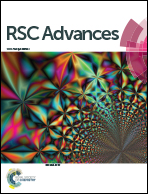Simultaneous enhancement in stability and efficiency of low-temperature processed perovskite solar cells†
Abstract
Mixed ion based perovskite solar cells (PSCs) have recently emerged as a promising photoactive material owing to their augmented electronic and light harvesting properties combined with stability enhancing characteristics. However, to date most of the high performing perovskite devices employ a high temperature (∼500° C) sintering process for depositing a conventional titanium oxide (TiO2) based electron transport layer (ETL), which is a serious bottleneck towards roll-to-roll processing with flexible substrates, large scale manufacturability and also results in high energy consumption. The present work demonstrates simultaneous enhancement in efficiency and stability in the perovskite solar cell that is totally fabricated using low temperature methods with the synthesis process temperature not exceeding 150 °C at any stage. The perovskite devices, thus fabricated, exhibited high power conversion efficiency of ∼14.5% and device stability > 570 hours (normalized PCE to reach 80% of its original value), which is the first of this kind of accomplishment ever reported in entirely low temperature processed PSCs. It is noteworthy to mention that the presented devices utilize a ∼360 °C lower temperature than required for the conventional TiO2 based PSCs to achieve similar enhancements in terms of stability and efficiency simultaneously. The high performing PSCs reported in this work incorporate mixed organic perovskite (MA0.6FA0.4PbI3) as the light absorber and aluminium-doped zinc oxide (AZO) as the electron transport layer. Adding to the merits, the MA0.6FA0.4PbI3/AZO devices exhibited a substantially low photocurrent hysteresis phenomenon. In order to examine the underlying causes of the efficiency and stability enhancements in AZO based devices, a low temperature processed MA0.6FA0.4PbI3/ZnO device was also fabricated and comparatively studied. Investigations reveal that the improved dark carrier mobility and superior interfacial electronic properties at the perovskite/AZO interface are attributed to their enriched device performance. Slow perovskite decomposition rate/high device stability with AZO based perovskite devices was found to be associated with the more hydrophobic and acidic nature of the AZO surface and the related interfacial interactions with the adjacent perovskite layer.


 Please wait while we load your content...
Please wait while we load your content...